Metal Oxide Heterostructures for Improving Gas Sensing Properties: A Review
Abstract
:1. Introduction
2. Gas Sensing Mechanisms of Metal Oxide Semiconductors
3. Heterostructure Classification
- -
- A dash between the names of two or more constituents such as SnO2-Co3O4 represents a simple mixture of SnO2 and Co3O4, which are not controlled and randomly distributed.
- -
- An “@” sign between two or more constituents such as SnO2@CuO represents the base material SnO2 with a second material CuO adding on it in some ways. For example, CuO is coated on SnO2 in the ways such as sputtering, dipping, etc.
- -
- A forward slash between constituents’ names such as ZnO/NiO represents a clear partition or a well-defined interface between these two materials. For example, ZnO/NiO could represent a bi-layer structure or core–shell ZnO/NiO nanorods.
3.1. Simple Mixed Compound Structures
3.2. Layered Structures
3.3. Structures Decorated with Second-Phase Particles
3.4. One-Dimensional Structures
3.5. Core–Shell Structures
4. Overview of Synthesis Methods
4.1. Sol-Gel Method
4.2. Hydrothermal–Solvothermal Synthesis Method
4.3. Vapor Deposition Method
4.4. Electrospinning Method
5. Mechanisms of Gas Sensing Enhancement with Heterostructures
5.1. Working Mechanisms of Gas Sensing Materials
5.2. Role of Heterojunction at the Interface
5.2.1. p–n Nanojunctions
5.2.2. n–n and p–p Nanojunctions
5.3. Synergistic Effect
5.4. Catalyzed Spill-Over Effect
5.5. Response Inversion Effect
6. Conclusions and Future Outlook
Author Contributions
Funding
Institutional Review Board Statement
Informed Consent Statement
Data Availability Statement
Conflicts of Interest
References
- Somov, A.; Baranov, A.; Savkin, A.; Spirjakin, D.; Spirjakin, A.; Passerone, R. Development of Wireless Sensor Network for Combustible Gas Monitoring. Sens. Actuators A Phys. 2011, 171, 398–405. [Google Scholar] [CrossRef]
- Aliyu, F.; Sheltami, T. Development of an Energy-Harvesting Toxic and Combustible Gas Sensor for Oil and Gas Industries. Sens. Actuators B Chem. 2016, 231, 265–275. [Google Scholar] [CrossRef]
- Kim, I.-D.; Rothschild, A.; Tuller, H.L. Advances and New Directions in Gas-Sensing Devices. Acta Mater. 2013, 61, 974–1000. [Google Scholar] [CrossRef]
- Lin, Z.; Li, N.; Chen, Z.; Fu, P. The Effect of Ni Doping Concentration on the Gas Sensing Properties of Ni Doped SnO2. Sens. Actuators B Chem. 2017, 239, 501–510. [Google Scholar] [CrossRef]
- Kolmakov, A.; Zhang, Y.; Cheng, G.; Moskovits, M. Detection of CO and O2 Using Tin Oxide Nanowire Sensors. Adv. Mater. 2003, 15, 997–1000. [Google Scholar] [CrossRef]
- Jing, Z.; Zhan, J. Fabrication and Gas-Sensing Properties of Porous ZnO Nanoplates. Adv. Mater. 2008, 20, 4547–4551. [Google Scholar] [CrossRef]
- Wilson, R.L.; Simion, C.E.; Blackman, C.S.; Carmalt, C.J.; Stanoiu, A.; Di Maggio, F.; Covington, J.A. The Effect of Film Thickness on the Gas Sensing Properties of Ultra-Thin TiO2 Films Deposited by Atomic Layer Deposition. Sensors 2018, 18, 735. [Google Scholar] [CrossRef] [Green Version]
- Wang, H.; Yan, L.; Li, S.; Li, Y.; Liu, L.; Du, L.; Duan, H.; Cheng, Y. Acetone Sensors Based on Microsheet-Assembled Hierarchical Fe2O3 with Different Fe3+ Concentrations. Appl. Phys. A 2018, 124, 212. [Google Scholar] [CrossRef]
- Han, D.; Zhai, L.; Gu, F.; Wang, Z. Highly Sensitive NO2 Gas Sensor of Ppb-Level Detection Based on In2O3 Nanobricks at Low Temperature. Sens. Actuators B Chem. 2018, 262, 655–663. [Google Scholar] [CrossRef]
- Hübner, M.; Simion, C.E.; Tomescu-Stănoiu, A.; Pokhrel, S.; Bârsan, N.; Weimar, U. Influence of Humidity on CO Sensing with P-Type CuO Thick Film Gas Sensors. Sens. Actuators B Chem. 2011, 153, 347–353. [Google Scholar] [CrossRef]
- Miller, D.R.; Akbar, S.A.; Morris, P.A. Nanoscale Metal Oxide-Based Heterojunctions for Gas Sensing: A Review. Sens. Actuators B Chem. 2014, 204, 250–272. [Google Scholar] [CrossRef]
- Guo, X.M.; Zhao, J.T.; Yin, X.T.; Huang, S.L. Sensitivity and Selectivity of SnO2-Based Sensor for CO and H2 Detections: A Novel Method to Detect Simultaneously the CO and H2 Concentrations. Adv. Sci. Technol. 2017, 99, 40–47. [Google Scholar] [CrossRef]
- Huo, L.; Yang, X.; Liu, Z.; Tian, X.; Qi, T.; Wang, X.; Yu, K.; Sun, J.; Fan, M. Modulation of Potential Barrier Heights in Co3O4/SnO2 Heterojunctions for Highly H2-Selective Sensors. Sens. Actuators B Chem. 2017, 244, 694–700. [Google Scholar] [CrossRef]
- Lupan, O.; Postica, V.; Cretu, V.; Wolff, N.; Duppel, V.; Kienle, L.; Adelung, R. Single and Networked CuO Nanowires for Highly Sensitive P-Type Semiconductor Gas Sensor Applications. Phys. Status Solidi-Rapid Res. Lett. 2016, 10, 260–266. [Google Scholar] [CrossRef]
- Liu, J.; Chen, T.; Jian, P.; Wang, L.; Yan, X. Hollow Urchin-like NiO/NiCo2O4 Heterostructures as Highly Efficient Catalysts for Selective Oxidation of Styrene. J. Colloid Interface Sci. 2018, 526, 295–301. [Google Scholar] [CrossRef] [PubMed]
- Zappa, D.; Galstyan, V.; Kaur, N.; Munasinghe Arachchige, H.M.M.; Sisman, O.; Comini, E. “Metal Oxide-Based Heterostructures for Gas Sensors”—A Review. Anal. Chim. Acta 2018, 1039, 1–23. [Google Scholar] [CrossRef]
- Xue, S.; Cao, S.; Huang, Z.; Yang, D.; Zhang, G. Improving Gas-Sensing Performance Based on MOS Nanomaterials: A Review. Materials 2021, 14, 4263. [Google Scholar] [CrossRef]
- Joshi, N.; Braunger, M.L.; Shimizu, F.M.; Riul, A.R., Jr.; Oliveira, O.N. Insights into Nano-Heterostructured Materials for Gas Sensing: A Review. Multifunct. Mater. 2021, 4, 032002. [Google Scholar] [CrossRef]
- Moon, W.J.; Yu, J.H.; Choi, G.M. The CO and H2 Gas Selectivity of CuO-Doped SnO2–ZnO Composite Gas Sensor. Sens. Actuators B Chem. 2002, 87, 464–470. [Google Scholar] [CrossRef]
- Patil, D.R.; Patil, L.A. Cr2O3-Modified ZnO Thick Film Resistors as LPG Sensors. Talanta 2009, 77, 1409–1414. [Google Scholar] [CrossRef]
- Yin, M.; Yao, Y.; Fan, H.; Liu, S. WO3-SnO2 Nanosheet Composites: Hydrothermal Synthesis and Gas Sensing Mechanism. J. Alloys Compd. 2018, 736, 322–331. [Google Scholar] [CrossRef]
- Drobek, M.; Kim, J.-H.; Bechelany, M.; Vallicari, C.; Julbe, A.; Kim, S.S. MOF-Based Membrane Encapsulated ZnO Nanowires for Enhanced Gas Sensor Selectivity. ACS Appl. Mater. Interfaces 2016, 8, 8323–8328. [Google Scholar] [CrossRef] [PubMed]
- Tian, H.; Fan, H.; Li, M.; Ma, L. Zeolitic Imidazolate Framework Coated ZnO Nanorods as Molecular Sieving to Improve Selectivity of Formaldehyde Gas Sensor. ACS Sens. 2016, 1, 243–250. [Google Scholar] [CrossRef]
- Absalan, S.; Nasresfahani, S.; Sheikhi, M.H. High-Performance Carbon Monoxide Gas Sensor Based on Palladium/Tin Oxide/Porous Graphitic Carbon Nitride Nanocomposite. J. Alloys Compd. 2019, 795, 79–90. [Google Scholar] [CrossRef]
- Kim, H.-J.; Lee, J.-H. Highly Sensitive and Selective Gas Sensors Using P-Type Oxide Semiconductors: Overview. Sens. Actuators B Chem. 2014, 192, 607–627. [Google Scholar] [CrossRef]
- Zhou, X.; Yang, L.; Bian, Y.; Ma, X.; Han, N.; Chen, Y. Coupling P+n Field-Effect Transistor Circuits for Low Concentration Methane Gas Detection. Sensors 2018, 18, 787. [Google Scholar] [CrossRef] [Green Version]
- Zeng, Y.; Zhang, K.; Wang, X.; Sui, Y.; Zou, B.; Zheng, W.; Zou, G. Rapid and Selective H2S Detection of Hierarchical ZnSnO3 Nanocages. Sens. Actuators B Chem. 2011, 159, 245–250. [Google Scholar] [CrossRef]
- Xu, L.; Xing, R.; Song, J.; Xu, W.; Song, H. ZnO–SnO2 Nanotubes Surface Engineered by Ag Nanoparticles: Synthesis, Characterization, and Highly Enhanced HCHO Gas Sensing Properties. J. Mater. Chem. C 2013, 1, 2174–2182. [Google Scholar] [CrossRef]
- Wang, Y.; Zhao, Z.; Sun, Y.; Li, P.; Ji, J.; Chen, Y.; Zhang, W.; Hu, J. Fabrication and Gas Sensing Properties of Au-Loaded SnO2 Composite Nanoparticles for Highly Sensitive Hydrogen Detection. Sens. Actuators B Chem. 2017, 240, 664–673. [Google Scholar] [CrossRef]
- Yin, X.-T.; Zhou, W.-D.; Li, J.; Wang, Q.; Wu, F.-Y.; Dastan, D.; Wang, D.; Garmestani, H.; Wang, X.-M.; Ţălu, Ş. A Highly Sensitivity and Selectivity Pt-SnO2 Nanoparticles for Sensing Applications at Extremely Low Level Hydrogen Gas Detection. J. Alloys Compd. 2019, 805, 229–236. [Google Scholar] [CrossRef]
- Yamazoe, N.; Kurokawa, Y.; Seiyama, T. Effects of Additives on Semiconductor Gas Sensors. Sens. Actuators 1983, 4, 283–289. [Google Scholar] [CrossRef]
- Lyson-Sypien, B.; Czapla, A.; Lubecka, M.; Kusior, E.; Zakrzewska, K.; Radecka, M.; Kusior, A.; Balogh, A.G.; Lauterbach, S.; Kleebe, H.-J. Gas Sensing Properties of TiO2–SnO2 Nanomaterials. Sens. Actuators B Chem. 2013, 187, 445–454. [Google Scholar] [CrossRef]
- Shaposhnik, D.; Pavelko, R.; Llobet, E.; Gispert-Guirado, F.; Vilanova, X. Hydrogen Sensors on the Basis of SnO2-TiO2 Systems. Procedia Eng. 2011, 25, 1133–1136. [Google Scholar] [CrossRef] [Green Version]
- Vasiliev, R.B.; Rumyantseva, M.N.; Podguzova, S.E.; Ryzhikov, A.S.; Ryabova, L.I.; Gaskov, A.M. Effect of Interdiffusion on Electrical and Gas Sensor Properties of CuO/SnO2 Heterostructure. Mater. Sci. Eng. B 1999, 57, 241–246. [Google Scholar] [CrossRef]
- Dandeneau, C.S.; Jeon, Y.-H.; Shelton, C.T.; Plant, T.K.; Cann, D.P.; Gibbons, B.J. Thin Film Chemical Sensors Based on P-CuO/n-ZnO Heterocontacts. Thin Solid Films 2009, 517, 4448–4454. [Google Scholar] [CrossRef]
- Zhu, Y.; Su, H.; Chen, Y.; Jin, Z.; Xu, J.; Zhang, D. A Facile Synthesis of PdO-Decorated SnO2 Nanocomposites with Open Porous Hierarchical Architectures for Gas Sensors. J. Am. Ceram. Soc. 2016, 99, 3770–3774. [Google Scholar] [CrossRef]
- Vuong, N.M.; Chinh, N.D.; Huy, B.T.; Lee, Y.-I. CuO-Decorated ZnO Hierarchical Nanostructures as Efficient and Established Sensing Materials for H2S Gas Sensors. Sci. Rep. 2016, 6, 26736. [Google Scholar] [CrossRef] [Green Version]
- Wang, Y.; Wang, S.; Zhang, H.; Gao, X.; Yang, J.; Wang, L. Brookite TiO2 Decorated α-Fe2O 3 Nanoheterostructures with Rod Morphologies for Gas Sensor Application. J. Mater. Chem. A 2014, 2, 7935–7943. [Google Scholar] [CrossRef]
- Asad, M.; Sheikhi, M.H. Surface Acoustic Wave Based H2S Gas Sensors Incorporating Sensitive Layers of Single Wall Carbon Nanotubes Decorated with Cu Nanoparticles. Sens. Actuators B Chem. 2014, 198, 134–141. [Google Scholar] [CrossRef]
- Lü, R.; Zhou, W.; Shi, K.; Yang, Y.; Wang, L.; Pan, K.; Tian, C.; Ren, Z.; Fu, H. Alumina Decorated TiO2 Nanotubes with Ordered Mesoporous Walls as High Sensitivity NOx Gas Sensors at Room Temperature. Nanoscale 2013, 5, 8569–8576. [Google Scholar] [CrossRef]
- Cao, J.; Qin, C.; Wang, Y.; Zhang, H.; Sun, G.; Zhang, Z. Solid-State Method Synthesis of SnO2-Decorated g-C3N4 Nanocomposites with Enhanced Gas-Sensing Property to Ethanol. Materials 2017, 10, 604. [Google Scholar] [CrossRef] [PubMed] [Green Version]
- Zhang, R.; Wang, Y.; Zhang, Z.; Cao, J. Highly Sensitive Acetone Gas Sensor Based on G-C3N4 Decorated MgFe2O4 Porous Microspheres Composites. Sensors 2018, 18, 2211. [Google Scholar] [CrossRef] [PubMed] [Green Version]
- Li, X.-Q.; Fan, Q.-F.; Li, G.-L.; Huang, Y.-H.; Gao, Z.; Fan, X.-M.; Zhang, C.-L.; Zhou, Z.-W. Syntheses of ZnO Nano-Arrays and Spike-Shaped CuO/ZnO Heterostructure. Acta Phys. Chim. Sin. 2015, 31, 783–792. [Google Scholar] [CrossRef]
- Katoch, A.; Byun, J.-H.; Choi, S.-W.; Kim, S.S. One-Pot Synthesis of Au-Loaded SnO2 Nanofibers and Their Gas Sensing Properties. Sens. Actuators B Chem. 2014, 202, 38–45. [Google Scholar] [CrossRef]
- Yoon, J.-W.; Jun Hong, Y.; Kang, Y.C.; Lee, J.-H. High Performance Chemiresistive H2S Sensors Using Ag-Loaded SnO2 Yolk–Shell Nanostructures. RSC Adv. 2014, 4, 16067–16074. [Google Scholar] [CrossRef]
- Yin, X.-T.; Lv, P.; Li, J. Study on Simultaneous Detection of CO and H2 with (Pd, Fe)-Modified SnO2 and Pt-Loaded SnO2 Sensors. J. Mater. Sci. Mater. Electron. 2018, 29, 18935–18940. [Google Scholar] [CrossRef]
- Liewhiran, C.; Tamaekong, N.; Wisitsoraat, A.; Tuantranont, A.; Phanichphant, S. Ultra-Sensitive H2 Sensors Based on Flame-Spray-Made Pd-Loaded SnO2 Sensing Films. Sens. Actuators B Chem. 2013, 176, 893–905. [Google Scholar] [CrossRef]
- Arafat, M.M.; Dinan, B.; Akbar, S.A.; Haseeb, A.S.M.A. Gas Sensors Based on One Dimensional Nanostructured Metal-Oxides: A Review. Sensors 2012, 12, 7207–7258. [Google Scholar] [CrossRef]
- Korotcenkov, G. Gas Response Control through Structural and Chemical Modification of Metal Oxide Films: State of the Art and Approaches. Sens. Actuators B Chem. 2005, 107, 209–232. [Google Scholar] [CrossRef]
- Wan, Q.; Li, Q.H.; Chen, Y.J.; Wang, T.H.; He, X.L.; Li, J.P.; Lin, C.L. Fabrication and Ethanol Sensing Characteristics of ZnO Nanowire Gas Sensors. Appl. Phys. Lett. 2004, 84, 3654–3656. [Google Scholar] [CrossRef]
- Hamidi, S.M.; Mosivand, A.; Mahboubi, M.; Arabi, H.; Azad, N.; Jamal, M.R. New Generation of α-MnO2 Nanowires @PDMS Composite as a Hydrogen Gas Sensor. Appl. Phys. A 2018, 124, 253. [Google Scholar] [CrossRef]
- Caicedo, N.; Leturcq, R.; Raskin, J.-P.; Flandre, D.; Lenoble, D. Detection Mechanism in Highly Sensitive ZnO Nanowires Network Gas Sensors. Sens. Actuators B Chem. 2019, 297, 126602. [Google Scholar] [CrossRef]
- Kim, J.-H.; Mirzaei, A.; Kim, H.W.; Kim, S.S. Low Power-Consumption CO Gas Sensors Based on Au-Functionalized SnO2-ZnO Core-Shell Nanowires. Sens. Actuators B Chem. 2018, 267, 597–607. [Google Scholar] [CrossRef]
- Hwang, I.-S.; Kim, S.-J.; Choi, J.-K.; Choi, J.; Ji, H.; Kim, G.-T.; Lee, J.-H. ZnO-SnO2 Core-Shell Nanowire Networks and Their Gas Sensing Characteristics. In Proceedings of the 2011 IEEE Nanotechnology Materials and Devices Conference, Jeju, Korea, 18–21 October 2011; pp. 396–397. [Google Scholar]
- Tian, X.; Wang, Q.; Chen, X.; Yang, W.; Wu, Z.; Xu, X.; Jiang, M.; Zhou, Z. Enhanced Performance of Core-Shell Structured Polyaniline at Helical Carbon Nanotube Hybrids for Ammonia Gas Sensor. Appl. Phys. Lett. 2014, 105, 203109. [Google Scholar] [CrossRef]
- Jin, W.; Chen, W.; Lu, Y.; Zhao, C.; Dai, Y. V2O5/Polypyrrole Core–Shell Nanotubes for Gas Sensor. J. Nanosci. Nanotechnol. 2011, 11, 10834–10838. [Google Scholar] [CrossRef] [PubMed]
- Pang, Z.; Yang, Z.; Chen, Y.; Zhang, J.; Wang, Q.; Huang, F.; Wei, Q. A Room Temperature Ammonia Gas Sensor Based on Cellulose/TiO2/PANI Composite Nanofibers. Colloids Surf. A 2016, 494, 248–255. [Google Scholar] [CrossRef]
- Li, C.; Chartuprayoon, N.; Bosze, W.; Low, K.; Lee, K.H.; Nam, J.; Myung, N.V. Electrospun Polyaniline/Poly(Ethylene Oxide) Composite Nanofibers Based Gas Sensor. Electroanalysis 2014, 26, 711–722. [Google Scholar] [CrossRef] [Green Version]
- TANG, W.; WANG, J.; YAO, P.-J.; DU, H.-Y.; SUN, Y.-H. Preparation, Characterization and Gas Sensing Mechanism of ZnO-Doped SnO2 Nanofibers. Acta Phys. Chim. Sin. 2014, 30, 781–788. [Google Scholar] [CrossRef]
- Zhuang, H.J.; Wang, D.; Wang, X.Y.; Wang, P.P.; Zheng, X.J. Preparation and Gas Sensing Properties of Porous CuO/ZnO Composite Nanofibers. J. Synth. Cryst. 2015, 206, 161–166. [Google Scholar]
- Guo, L.; Kou, X.; Ding, M.; Wang, C.; Dong, L.; Zhang, H.; Feng, C.; Sun, Y.; Gao, Y.; Sun, P.; et al. Reduced Graphene Oxide/α-Fe2O3 Composite Nanofibers for Application in Gas Sensors. Sens. Actuators B Chem. 2017, 244, 233–242. [Google Scholar] [CrossRef]
- Li, T.; Zeng, W.; Wang, Z. Quasi-One-Dimensional Metal-Oxide-Based Heterostructural Gas-Sensing Materials: A Review. Sens. Actuators B Chem. 2015, 221, 1570–1585. [Google Scholar] [CrossRef]
- Wu, X.; Xiong, S.; Mao, Z.; Hu, S.; Long, X. A Designed ZnO@ZIF-8 Core–Shell Nanorod Film as a Gas Sensor with Excellent Selectivity for H2 over CO. Chemistry 2017, 23, 7969–7975. [Google Scholar] [CrossRef] [PubMed] [Green Version]
- Jiang, W.; Bao, Z. Effect of Polyethylene Glycol on Microstructure and Photocatalysis of TiO2 Thin Films by Non-Hydrolytic Sol-Gel Processing. Chin. Ceram. Soc. 2008, 36, 187–191. [Google Scholar]
- Hernández, S.; Cauda, V.; Chiodoni, A.; Dallorto, S.; Sacco, A.; Hidalgo, D.; Celasco, E.; Pirri, C.F. Optimization of 1D ZnO@TiO2 Core–Shell Nanostructures for Enhanced Photoelectrochemical Water Splitting under Solar Light Illumination. ACS Appl. Mater. Interfaces 2014, 6, 12153–12167. [Google Scholar] [CrossRef] [PubMed]
- Meng, F.-J.; Guo, X.-M. Tuning the Oxygen Defects and Fermi Levels via In3+ Doping in SnO2-In2O3 Nanocomposite for Efficient CO Detection. Sens. Actuators B Chem. 2022, 357, 131412. [Google Scholar] [CrossRef]
- Galstyan, V. Porous TiO2-Based Gas Sensors for Cyber Chemical Systems to Provide Security and Medical Diagnosis. Sensors 2017, 17, 2947. [Google Scholar] [CrossRef] [Green Version]
- Liu, H.; Zhou, Q.; Zhang, Q.; Hong, C.; Xu, L.; Jin, L.; Chen, W. Synthesis, Characterization and Enhanced Sensing Properties of a NiO/ZnO p–n Junctions Sensor for the SF6 Decomposition Byproducts SO2, SO2F2, and SOF2. Sensors 2017, 17, 913. [Google Scholar] [CrossRef] [Green Version]
- Chen, G.; Ji, S.; Li, H.; Kang, X.; Chang, S.; Wang, Y.; Yu, G.; Lu, J.; Claverie, J.; Sang, Y.; et al. High-Energy Faceted SnO2-Coated TiO2 Nanobelt Heterostructure for Near-Ambient Temperature-Responsive Ethanol Sensor. ACS Appl. Mater. Interfaces 2015, 7, 24950–24956. [Google Scholar] [CrossRef]
- Liu, C.; Zhao, L.; Wang, B.; Sun, P.; Wang, Q.; Gao, Y.; Liang, X.; Zhang, T.; Lu, G. Acetone Gas Sensor Based on NiO/ZnO Hollow Spheres: Fast Response and Recovery, and Low (Ppb) Detection Limit. J. Colloid Interface Sci. 2017, 495, 207–215. [Google Scholar] [CrossRef]
- Gao, P.; Wang, Z.L. Self-Assembled Nanowire−Nanoribbon Junction Arrays of ZnO. J. Phys. Chem. B 2002, 106, 12653–12658. [Google Scholar] [CrossRef]
- Jiang, S.; Ge, B.; Xu, B.; Wang, Q.; Cao, B. In Situ Growth of ZnO/SnO2 (ZnO:Sn) m Binary/Superlattice Heterojunction Nanowire Arrays. CrystEngComm 2018, 20, 556–562. [Google Scholar] [CrossRef]
- Comini, E.; Baratto, C.; Concina, I.; Faglia, G.; Falasconi, M.; Ferroni, M.; Galstyan, V.; Gobbi, E.; Ponzoni, A.; Vomiero, A.; et al. Metal Oxide Nanoscience and Nanotechnology for Chemical Sensors. Sens. Actuators B Chem. 2013, 179, 3–20. [Google Scholar] [CrossRef]
- Choi, S.-W.; Katoch, A.; Sun, G.-J.; Kim, S.S. Synthesis and Gas Sensing Performance of ZnO–SnO2 Nanofiber–Nanowire Stem-Branch Heterostructure. Sens. Actuators B Chem. 2013, 181, 787–794. [Google Scholar] [CrossRef]
- Reneker, D.H.; Yarin, A.L. Electrospinning Jets and Polymer Nanofibers. Polymer 2008, 49, 2387–2425. [Google Scholar] [CrossRef] [Green Version]
- Li, F.; Gao, X.; Wang, R.; Zhang, T.; Lu, G. Study on TiO2-SnO2 Core-Shell Heterostructure Nanofibers with Different Work Function and Its Application in Gas Sensor. Sens. Actuators B Chem. 2017, 248, 812–819. [Google Scholar] [CrossRef]
- Gao, S.; Zhao, Y.; Wang, W.; Zhao, J.; Wang, X. Au/CuO/Cu2O Heterostructures for Conductometric Triethylamine Gas Sensing. Sens. Actuators B Chem. 2022, 371, 132515. [Google Scholar] [CrossRef]
- Dey, A. Semiconductor Metal Oxide Gas Sensors: A Review. Mater. Sci. Eng. B 2018, 229, 206–217. [Google Scholar] [CrossRef]
- Kaur, N.; Comini, E.; Poli, N.; Zappa, D.; Sberveglieri, G. NiO/ZnO Nanowire-Heterostructures by Vapor Phase Growth for Gas Sensing. Procedia Eng. 2016, 168, 1140–1143. [Google Scholar] [CrossRef] [Green Version]
- Kaur, N.; Comini, E.; Zappa, D.; Poli, N.; Sberveglieri, G. Nickel Oxide Nanowires: Vapor Liquid Solid Synthesis and Integration into a Gas Sensing Device. Nanotechnology 2016, 27, 205701. [Google Scholar] [CrossRef]
- Zappa, D.; Comini, E.; Sberveglieri, G. Thermally Oxidized Zinc Oxide Nanowires for Use as Chemical Sensors. Nanotechnology 2013, 24, 444008. [Google Scholar] [CrossRef]
- Kruefu, V.; Wisitsoraat, A.; Tuantranont, A.; Phanichphant, S. Ultra-Sensitive H2S Sensors Based on Hydrothermal/Impregnation-Made Ru-Functionalized WO3 Nanorods. Sens. Actuators B Chem. 2015, 215, 630–636. [Google Scholar] [CrossRef]
- Raksa, P.; Gardchareon, A.; Chairuangsri, T.; Mangkorntong, P.; Mangkorntong, N.; Choopun, S. Ethanol Sensing Properties of CuO Nanowires Prepared by an Oxidation Reaction. Ceram. Int. 2009, 35, 649–652. [Google Scholar] [CrossRef]
- Xu, Q.-H.; Xu, D.-M.; Guan, M.-Y.; Guo, Y.; Qi, Q.; Li, G.-D. ZnO/Al2O3/CeO2 Composite with Enhanced Gas Sensing Performance. Sens. Actuators B Chem. 2013, 177, 1134–1141. [Google Scholar] [CrossRef]
- Luo, Y.; Zhang, C. Pt-Activated TiO2-MoS2 Nanocomposites for H2 Detection at Low Temperature. J. Alloys Compd. 2018, 747, 550–557. [Google Scholar] [CrossRef]
- Song, L.; Yang, L.; Wang, Z.; Liu, D.; Luo, L.; Zhu, X.; Xi, Y.; Yang, Z.; Han, N.; Wang, F.; et al. One-Step Electrospun SnO2/MOx Heterostructured Nanomaterials for Highly Selective Gas Sensor Array Integration. Sens. Actuators B Chem. 2019, 283, 793–801. [Google Scholar] [CrossRef]
- Liang, J.; Yang, R.; Zhu, K.; Hu, M. Room Temperature Acetone-Sensing Properties of Branch-like VO2 (B)@ZnO Hierarchical Hetero-Nanostructures. J. Mater. Sci. Mater. Electron. 2018, 29, 3780–3789. [Google Scholar] [CrossRef]
- Korotcenkov, G. Metal Oxides for Solid-State Gas Sensors: What Determines Our Choice? Mater. Sci. Eng. B 2007, 139, 1–23. [Google Scholar] [CrossRef]
- Liu, C.; Wang, B.; Liu, T.; Sun, P.; Gao, Y.; Liu, F.; Lu, G. Facile Synthesis and Gas Sensing Properties of the Flower-like NiO-Decorated ZnO Microstructures. Sens. Actuators B Chem. 2016, 235, 294–301. [Google Scholar] [CrossRef]
- San, X.; Wang, G.; Liang, B.; Song, Y.; Gao, S.; Zhang, J.; Meng, F. Catalyst-Free Growth of One-Dimensional ZnO Nanostructures on SiO2 Substrate and in Situ Investigation of Their H2 Sensing Properties. J. Alloys Compd. 2015, 622, 73–78. [Google Scholar] [CrossRef]
- Giebelhaus, I.; Varechkina, E.; Fischer, T.; Rumyantseva, M.; Ivanov, V.; Gaskov, A.; Ramon Morante, J.; Arbiol, J.; Tyrra, W.; Mathur, S. One-Dimensional CuO–Sn2 p–n Heterojunctions for Enhanced Detection of H2S. J. Mater. Chem. A 2013, 1, 11261–11268. [Google Scholar] [CrossRef]
- Shao, F.; Hoffmann, M.W.G.; Prades, J.D.; Zamani, R.; Arbiol, J.; Morante, J.R.; Varechkina, E.; Rumyantseva, M.; Gaskov, A.; Giebelhaus, I.; et al. Heterostructured P-CuO (Nanoparticle)/n-SnO2 (Nanowire) Devices for Selective H2S Detection. Sens. Actuators B Chem. 2013, 181, 130–135. [Google Scholar] [CrossRef]
- Liu, X.; Du, B.; Sun, Y.; Yu, M.; Yin, Y.; Tang, W.; Chen, C.; Sun, L.; Yang, B.; Cao, W.; et al. Sensitive Room Temperature Photoluminescence-Based Sensing of H2S with Novel CuO–ZnO Nanorods. ACS Appl. Mater. Interfaces 2016, 8, 16379–16385. [Google Scholar] [CrossRef] [PubMed]
- Mashock, M.; Yu, K.; Cui, S.; Mao, S.; Lu, G.; Chen, J. Modulating Gas Sensing Properties of CuO Nanowires through Creation of Discrete Nanosized p–n Junctions on Their Surfaces. ACS Appl. Mater. Interfaces 2012, 4, 4192–4199. [Google Scholar] [CrossRef] [PubMed]
- Sen, S.; Kanitkar, P.; Sharma, A.; Muthe, K.P.; Rath, A.; Deshpande, S.K.; Kaur, M.; Aiyer, R.C.; Gupta, S.K.; Yakhmi, J.V. Growth of SnO2/W18O49 Nanowire Hierarchical Heterostructure and Their Application as Chemical Sensor. Sens. Actuators B Chem. 2010, 147, 453–460. [Google Scholar] [CrossRef]
- Sonker, R.K.; Sharma, A.; Tomar, M.; Gupta, V.; Yadav, B.C. Low Temperature Operated NO2 Gas Sensor Based on SnO2–ZnO Nanocomposite Thin Film. Adv. Sci. Lett. 2014, 20, 911–916. [Google Scholar] [CrossRef]
- Manjula, N.; Selvan, G.; Rajan, S.T.; Ayeshamariam, A.; Muthuraja, S.; Jayachandran, M. Properties of SnO2-TiO2 Composite Films Deposited Using Jet Nebulizer Spray Pyrolysis for Gas Sensors. Mater. Sci. Forum 2015, 832, 94–101. [Google Scholar] [CrossRef]
- Xu, H.; Zhang, J.; Rehman, A.U.; Gong, L.; Kan, K.; Li, L.; Shi, K. Synthesis of NiO@CuO Nanocomposite as High-Performance Gas Sensing Material for NO2 at Room Temperature. Appl. Surf. Sci. 2017, 412, 230–237. [Google Scholar] [CrossRef]
- Lou, Z.; Li, F.; Deng, J.; Wang, L.; Zhang, T. Branch-like Hierarchical Heterostructure (α-Fe2O3/TiO2): A Novel Sensing Material for Trimethylamine Gas Sensor. ACS Appl. Mater. Interfaces 2013, 5, 12310–12316. [Google Scholar] [CrossRef]
- Deng, J.; Yu, B.; Lou, Z.; Wang, L.; Wang, R.; Zhang, T. Facile Synthesis and Enhanced Ethanol Sensing Properties of the Brush-like ZnO–TiO2 Heterojunctions Nanofibers. Sens. Actuators B Chem. 2013, 184, 21–26. [Google Scholar] [CrossRef]
- Ivanovskaya, M.; Kotsikau, D.; Faglia, G.; Nelli, P.; Irkaev, S. Gas-Sensitive Properties of Thin Film Heterojunction Structures Based on Fe2O3–In2O3 Nanocomposites. Sens. Actuators B Chem. 2003, 93, 422–430. [Google Scholar] [CrossRef] [Green Version]
- de Lacy Costello, B.P.J.; Ewen, R.J.; Jones, P.R.H.; Ratcliffe, N.M.; Wat, R.K.M. A Study of the Catalytic and Vapour-Sensing Properties of Zinc Oxide and Tin Dioxide in Relation to 1-Butanol and Dimethyldisulphide. Sens. Actuators B Chem. 1999, 61, 199–207. [Google Scholar] [CrossRef]
- Kamble, V.B.; Umarji, A.M. Achieving Selectivity from the Synergistic Effect of Cr and Pt Activated SnO2 Thin Film Gas Sensors. Sens. Actuators B Chem. 2016, 236, 208–217. [Google Scholar] [CrossRef]
- Van Tong, P.; Hoa, N.D.; Van Duy, N.; Le, D.T.T.; Van Hieu, N. Enhancement of Gas-Sensing Characteristics of Hydrothermally Synthesized WO3 Nanorods by Surface Decoration with Pd Nanoparticles. Sens. Actuators B Chem. 2016, 223, 453–460. [Google Scholar] [CrossRef]
- Yin, X.-T.; Guo, X.-M. Sensitivity and Selectivity of (Au, Pt, Pd)-Loaded and (In, Fe)-Doped SnO2 Sensors for H2 and CO Detection. J. Mater. Sci. Mater. Electron. 2014, 25, 4960–4966. [Google Scholar] [CrossRef]
- Yin, X.-T.; Guo, X.-M. Selectivity and Sensitivity of Pd-Loaded and Fe-Doped SnO2 Sensor for CO Detection. Sens. Actuators B Chem. 2014, 200, 213–218. [Google Scholar] [CrossRef]
- Lu, Z.; Zhou, Q.; Xu, L.; Gui, Y.; Zhao, Z.; Tang, C.; Chen, W. Synthesis and Characterization of Highly Sensitive Hydrogen (H2) Sensing Device Based on Ag Doped SnO2 Nanospheres. Materials 2018, 11, 492. [Google Scholar] [CrossRef] [Green Version]
- Kim, S.-J.; Na, C.W.; Hwang, I.-S.; Lee, J.-H. One-Pot Hydrothermal Synthesis of CuO–ZnO Composite Hollow Spheres for Selective H2S Detection. Sens. Actuators B Chem. 2012, 168, 83–89. [Google Scholar] [CrossRef]
- Kim, S.S.; Na, H.G.; Choi, S.-W.; Kwak, D.S.; Kim, H.W. Novel Growth of CuO-Functionalized, Branched SnO2 Nanowires and Their Application to H2S Sensors. J. Phys. D Appl. Phys. 2012, 45, 205301. [Google Scholar] [CrossRef]
- Zhou, Q.; Xu, L.; Umar, A.; Chen, W.; Kumar, R. Pt Nanoparticles Decorated SnO2 Nanoneedles for Efficient CO Gas Sensing Applications. Sens. Actuators B Chem. 2018, 256, 656–664. [Google Scholar] [CrossRef]
- Kosc, I.; Hotovy, I.; Rehacek, V.; Griesseler, R.; Predanocy, M.; Wilke, M.; Spiess, L. Sputtered TiO2 Thin Films with NiO Additives for Hydrogen Detection. Appl. Surf. Sci. 2013, 269, 110–115. [Google Scholar] [CrossRef]
- Huang, H.; Gong, H.; Chow, C.L.; Guo, J.; White, T.J.; Tse, M.S.; Tan, O.K. Low-Temperature Growth of SnO2 Nanorod Arrays and Tunable n–p–n Sensing Response of a ZnO/SnO2 Heterojunction for Exclusive Hydrogen Sensors. Adv. Funct. Mater. 2011, 21, 2680–2686. [Google Scholar] [CrossRef]
- Yin, X.-T.; Wu, S.-S.; Dastan, D.; Nie, S.; Liu, Y.; Li, Z.-G.; Zhou, Y.-W.; Li, J.; Faik, A.; Shan, K.; et al. Sensing Selectivity of SnO2-Mn3O4 Nanocomposite Sensors for the Detection of H2 and CO Gases. Surf. Interfaces 2021, 25, 101190. [Google Scholar] [CrossRef]
- Yin, X.-T.; Li, J.; Wang, Q.; Dastan, D.; Shi, Z.-C.; Alharbi, N.; Garmestani, H.; Tan, X.-M.; Liu, Y.; Ma, X.-G. Opposite Sensing Response of Heterojunction Gas Sensors Based on SnO2–Cr2O3 Nanocomposites to H2 against CO and Its Selectivity Mechanism. Langmuir 2021, 37, 13548–13558. [Google Scholar] [CrossRef] [PubMed]
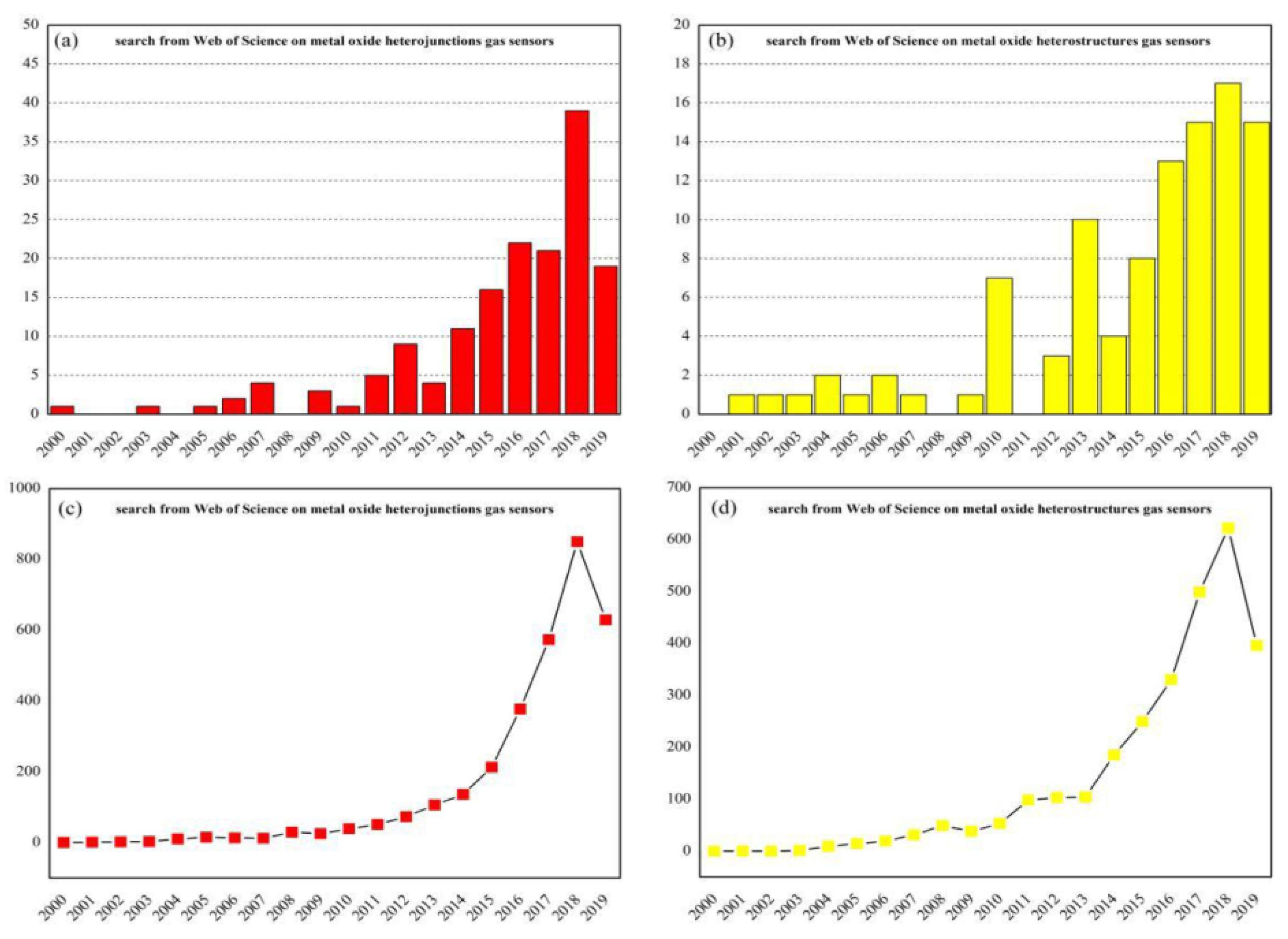

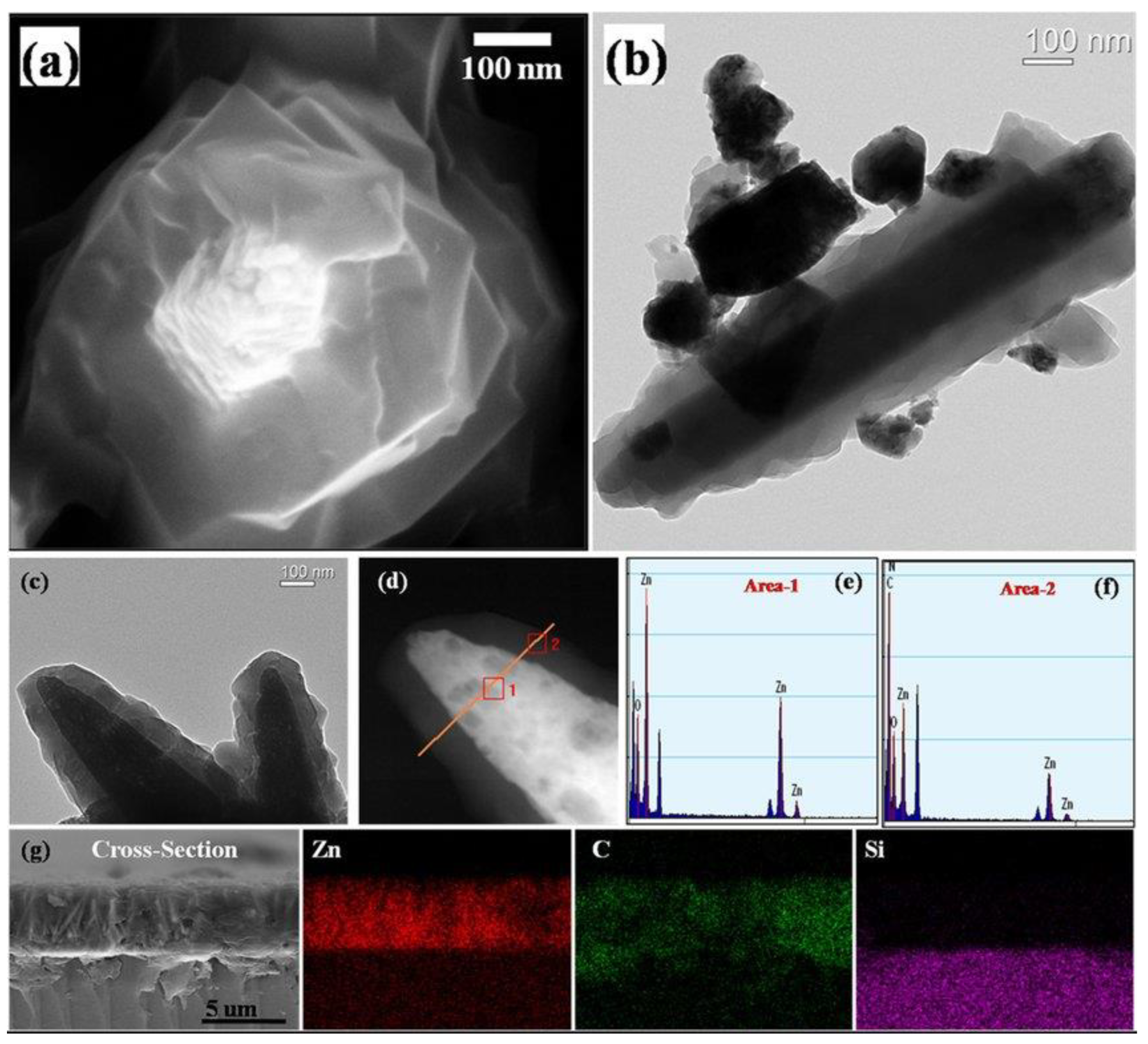


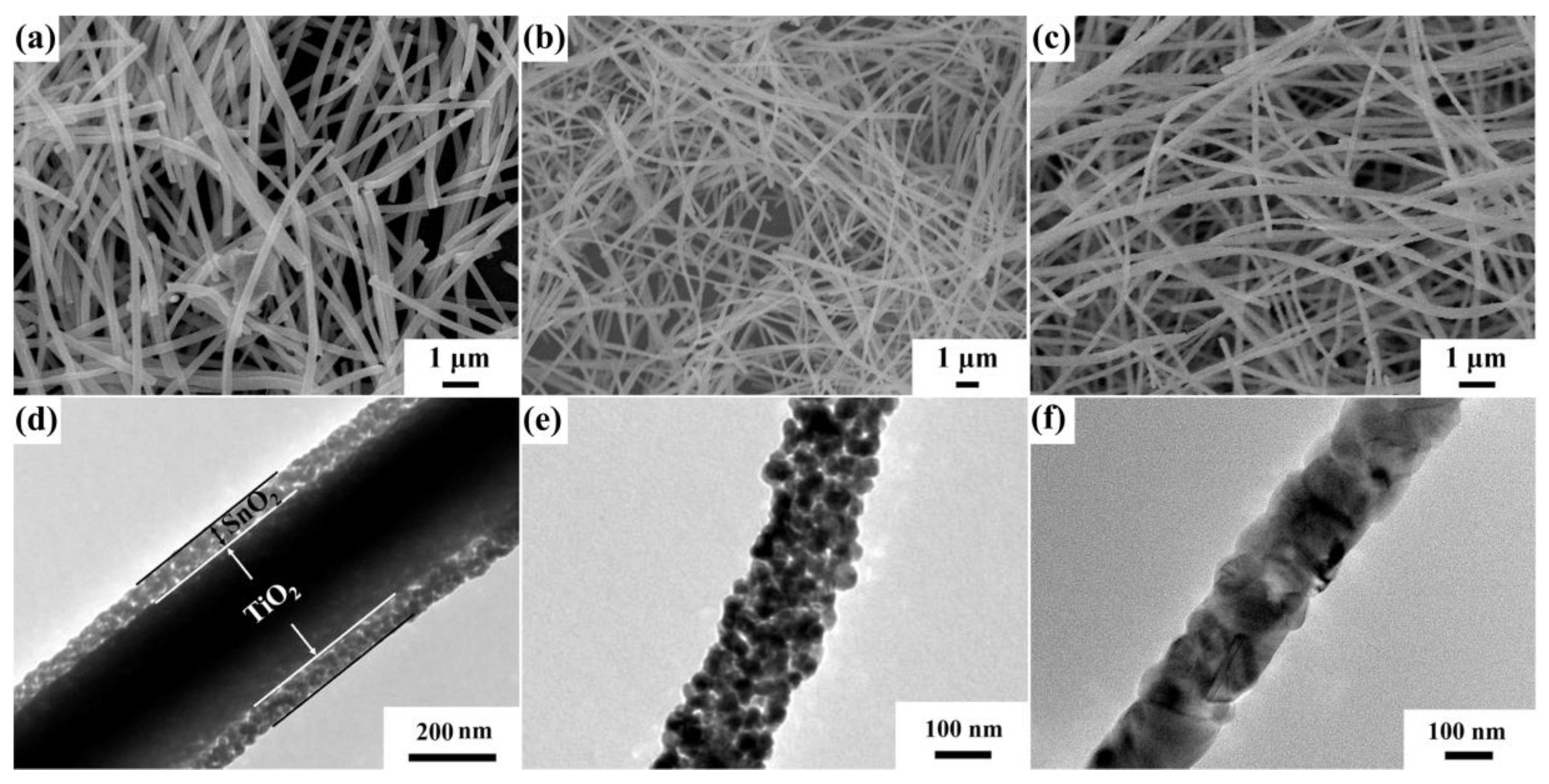
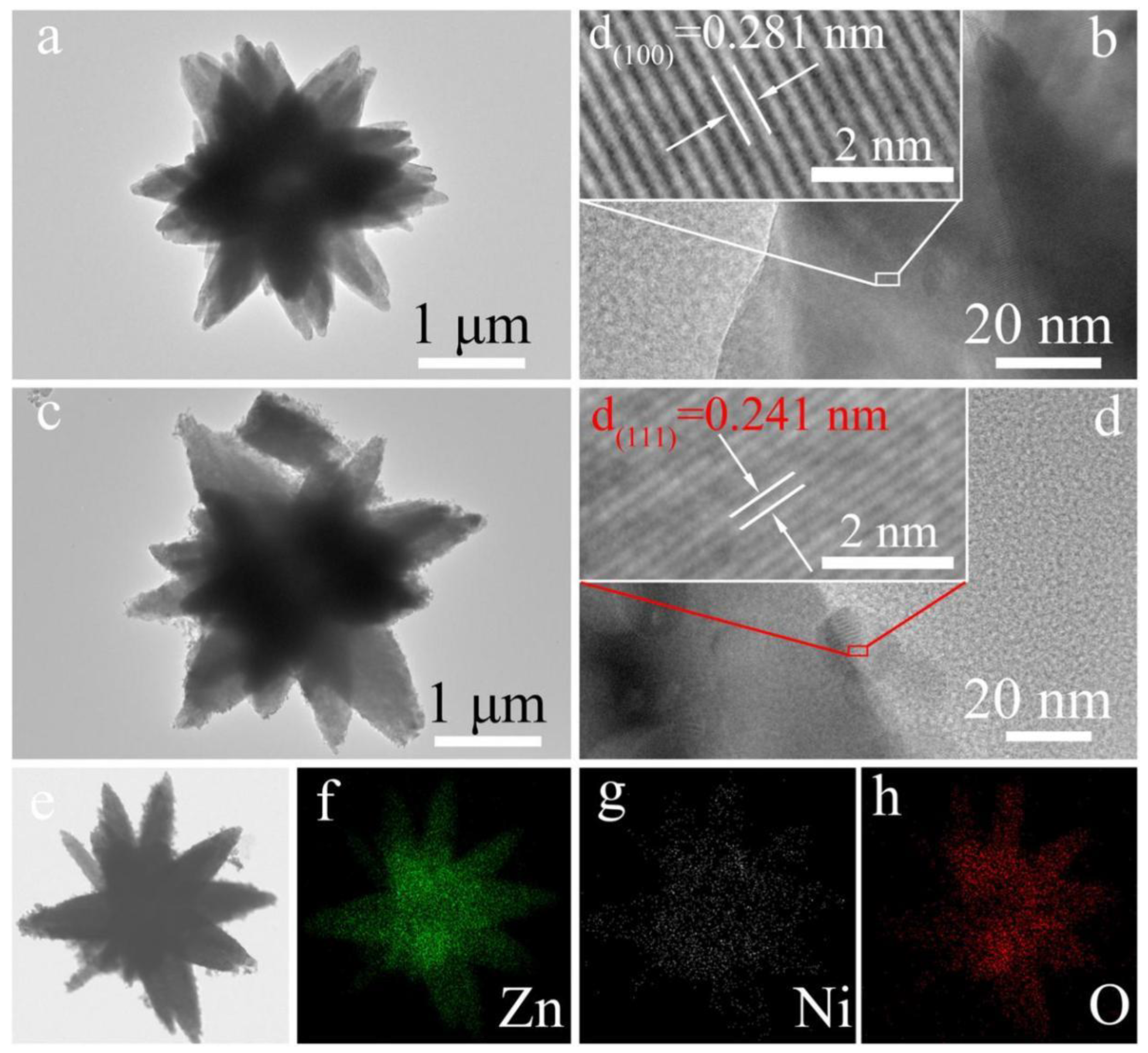
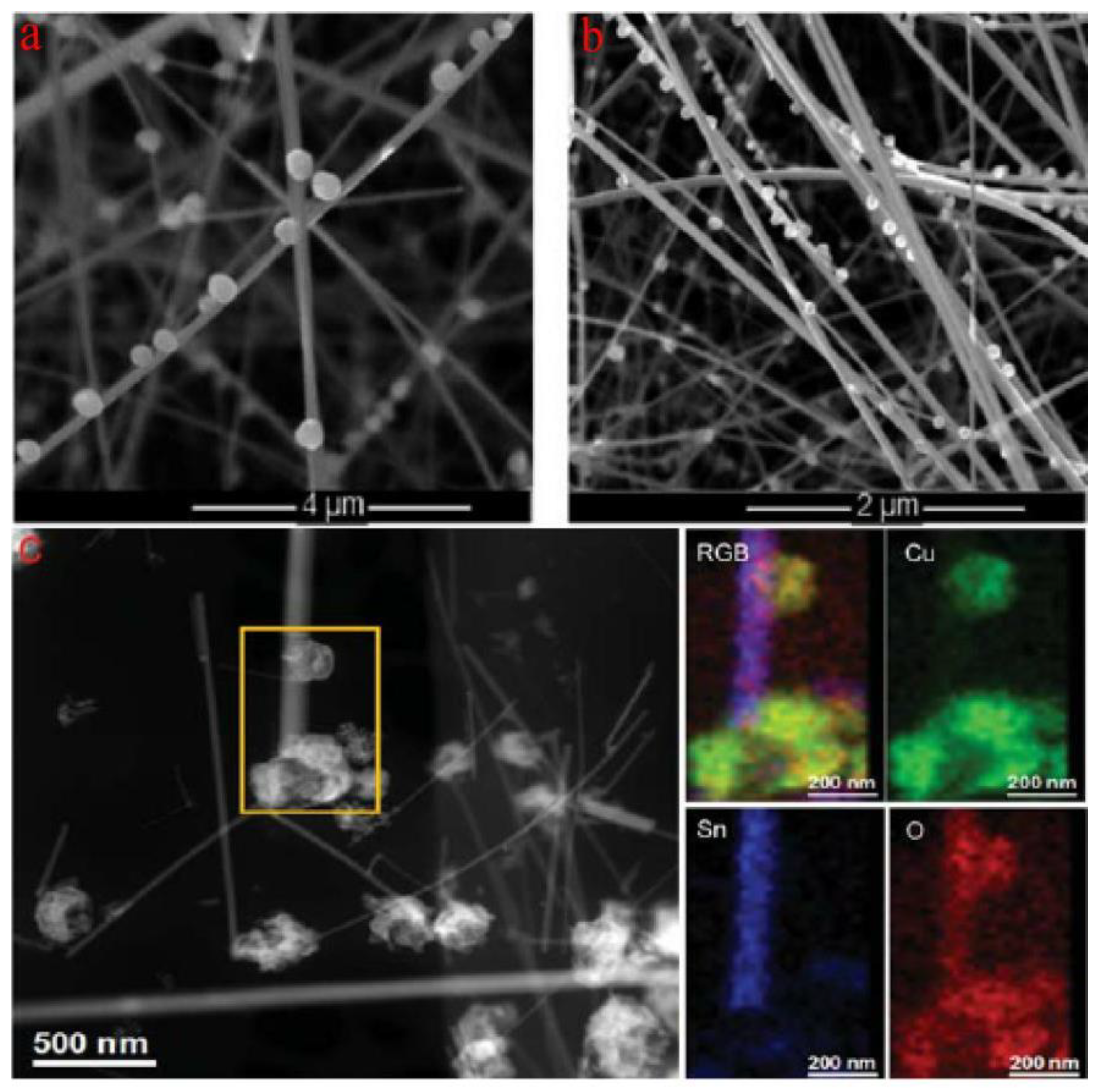
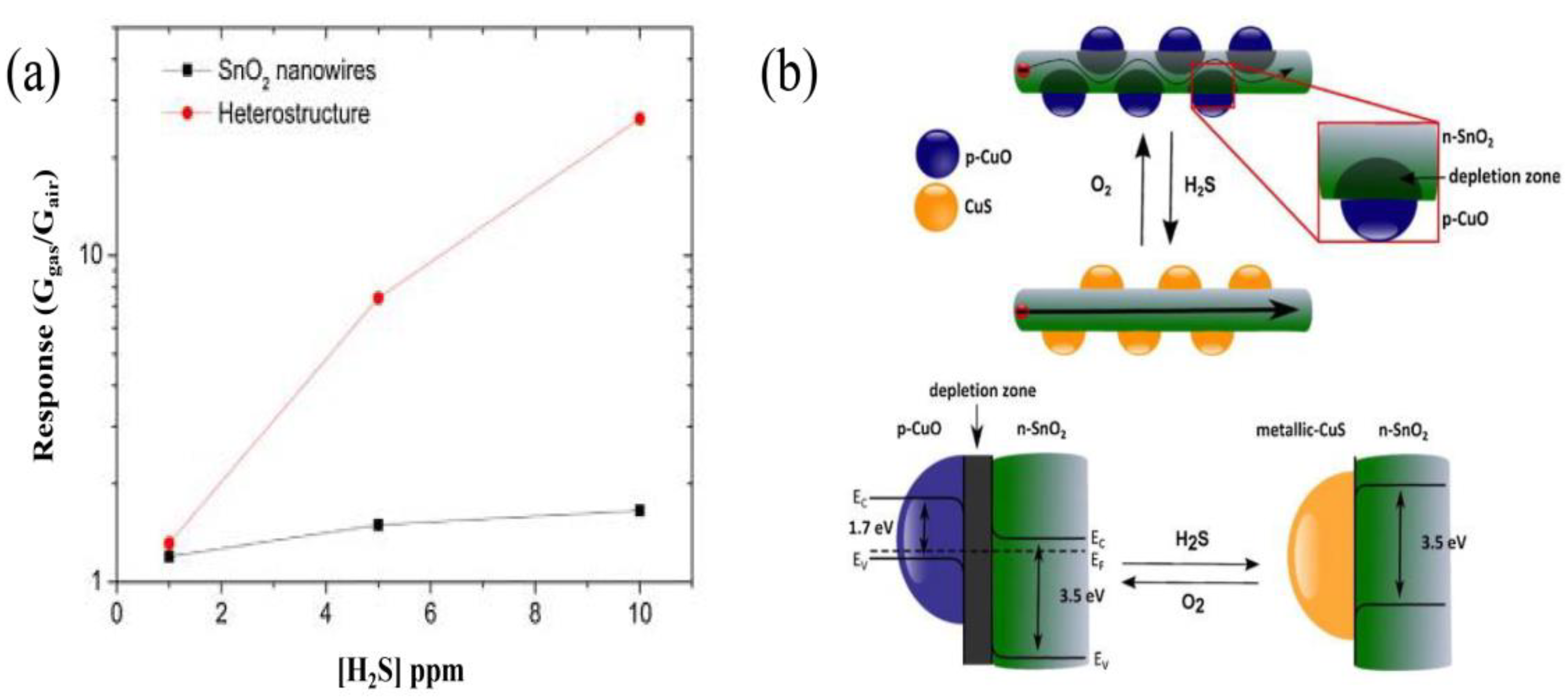
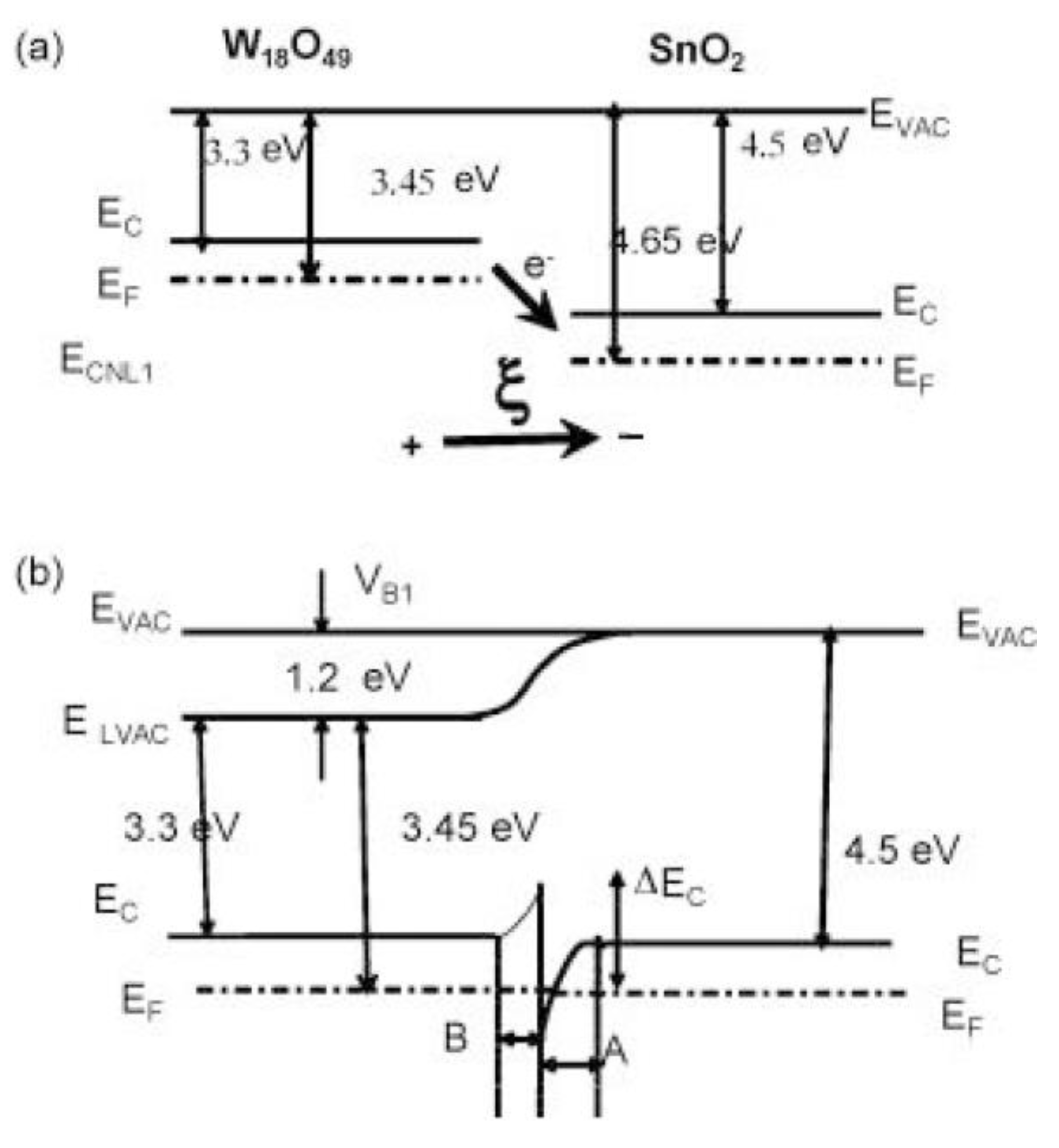

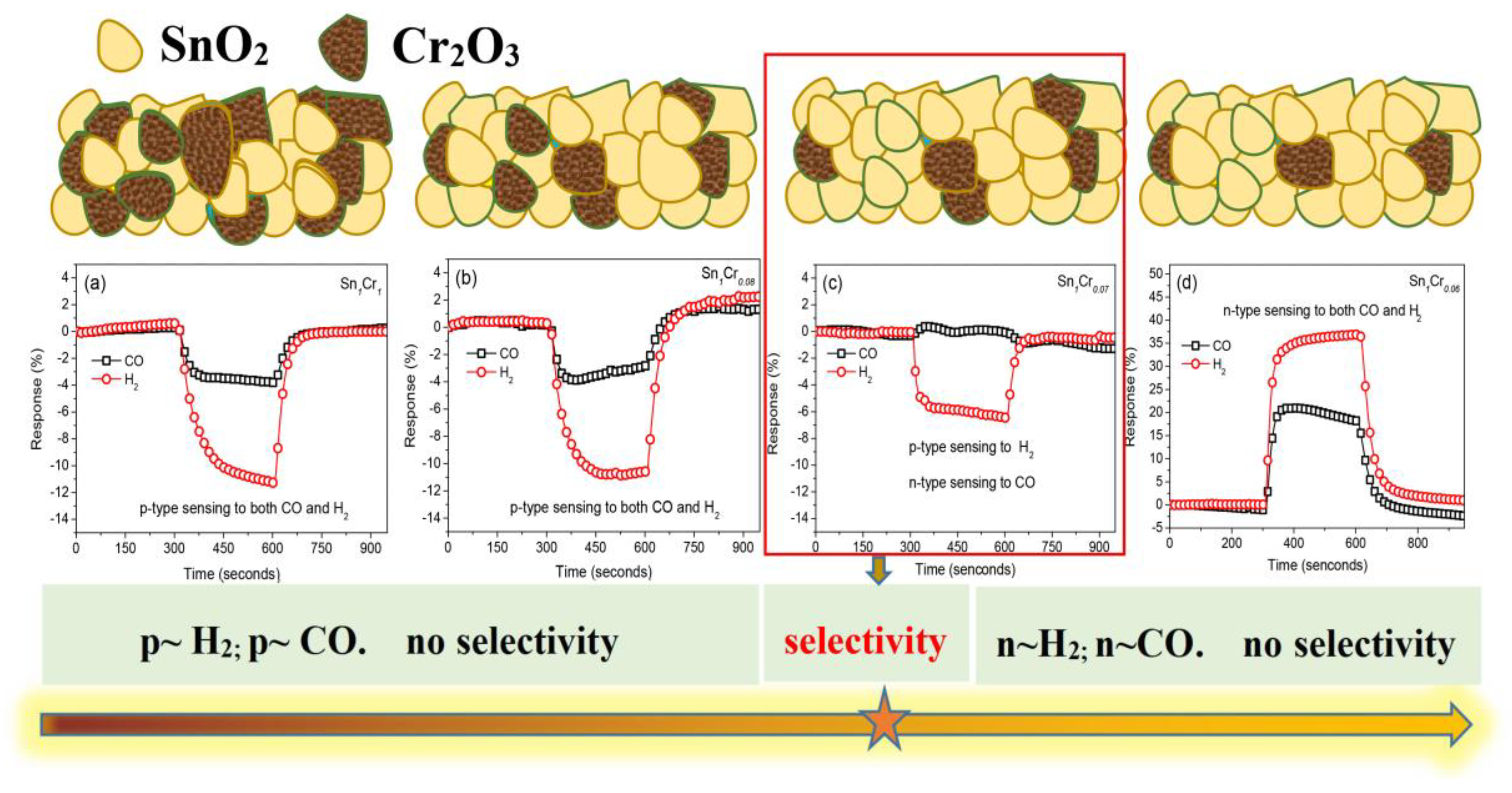
| Material Type | Dominant Charge Carrier | Reducing Gas | Oxidizing Gas |
|---|---|---|---|
| n-type | electrons (e−) | resistance decreases | resistance increases |
| p-type | holes (h+) | resistance increases | resistance decreases |
| Material Type of Conductivity | Materials | |
|---|---|---|
| MOS | Semiconductors | |
| n | SnO2, ZnO, TiO2, Al2O3, In2O3, V2O5, WO3 | SiC, g-C3N4, GaN |
| p | CuO, NiO, Co3O4, PdO, Cr2O3, Y2O3 | |
| n, p | Fe2O3, HgO2 | Si, GaAs, InP |
Disclaimer/Publisher’s Note: The statements, opinions and data contained in all publications are solely those of the individual author(s) and contributor(s) and not of MDPI and/or the editor(s). MDPI and/or the editor(s) disclaim responsibility for any injury to people or property resulting from any ideas, methods, instructions or products referred to in the content. |
© 2022 by the authors. Licensee MDPI, Basel, Switzerland. This article is an open access article distributed under the terms and conditions of the Creative Commons Attribution (CC BY) license (https://creativecommons.org/licenses/by/4.0/).
Share and Cite
Meng, F.-J.; Xin, R.-F.; Li, S.-X. Metal Oxide Heterostructures for Improving Gas Sensing Properties: A Review. Materials 2023, 16, 263. https://doi.org/10.3390/ma16010263
Meng F-J, Xin R-F, Li S-X. Metal Oxide Heterostructures for Improving Gas Sensing Properties: A Review. Materials. 2023; 16(1):263. https://doi.org/10.3390/ma16010263
Chicago/Turabian StyleMeng, Fan-Jian, Rui-Feng Xin, and Shan-Xin Li. 2023. "Metal Oxide Heterostructures for Improving Gas Sensing Properties: A Review" Materials 16, no. 1: 263. https://doi.org/10.3390/ma16010263





